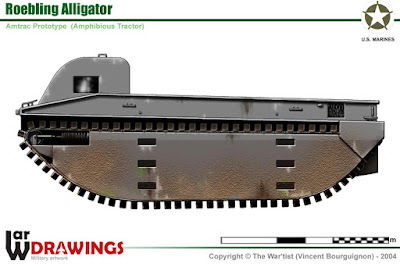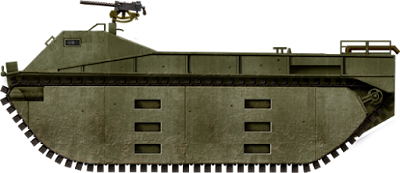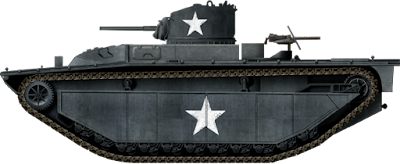LVT(A)-4 with ZiS-2 57 mm gun
LVT(A)-4 with ZiS-2 57 mm gun

LTV(A)-4 with ZiS-2 57 mm gun. Source: Tanks encyclopedia.
( http://www.tanks-encyclopedia.com/ww2/China/LVTA4-ZIS2-PLA.png )
The LVT(A)-4 is an American-made amphibious assault armored vehicle that was adapted to use the Soviet 57 mm ZIS-2 cannon and served in the Chinese People’s Liberation Army from late World War II until the 1960s.
The idea of a tracked landing vehicle ( LVT ) was born from a civil initiative. In the United States in the 1930s, engineer Ronald Roebling designed an amphibious vehicle capable of moving through the swampy areas of Florida or to be used in rescue operations, necessary due to the frequent flooding caused by hurricanes.
The idea was to have a body or “bathtub” equipped with a motor with enough power to be able to move on chains both on land and in water.
Roebling completed his first prototype, which he called the " Alligator ," in 1935. He further refined the model with a second prototype in 1937. This prototype caught the attention of the United States Marine Corps as they were developing their concept of amphibious warfare. Although Roebling was initially reluctant to allow his invention to be used for military purposes, the subsequent entry of the United States into the war changed his mind. He gave the patent to the government and even entered into a partnership with United Defense for its production.

Roebling prototype, 1937.
Source: Wardrawings
( http://www.wardrawings.be/WW2/Images/1-Vehicles(bis)/USA/6-LVT/Alligator/p1.jpg )
The first military prototype was officially designated LVT-1 “Alligator” (nickname inherited from the civilian prototypes). Although in military circles it was also known as “Amtrac” (Amphibious track). It was conceived as a logistics transport (capacity for 18 men or 2,041 kg of cargo) and had its baptism of fire in 1942 in Guadalcanal. Its tracked traction allowed it to overcome coral reefs, but its weak protection and armament made it easy to prey for Japanese weapons. Despite this, its use as a troop transport in amphibious assault was tested in Bougainville, where casualties were high.

LVT-1 “Alligator”, Guadalcanal, 1942.
Source: Tanks encyclopedia.
( http://www.tanks-encyclopedia.com/ww2/US/LVT/LVT1/LVT-1_Alligator.png )
The conclusions indicated that the LVT-1 fulfilled the logistic function perfectly but was not prepared to be an assault platform and support by fire. For this reason the LVT(A)-1 was designed . The designation (A) indicates armoured. Basically it consisted of an LVT-2 to which armour was added, the cargo area was covered and on its roof a turret of the M3 Sruart light tank was installed, with a 37 mm cannon to provide direct fire in the first phases of the landing, in those moments prior to the landing of the combat tanks and other heavy support weapons. They were used en masse for the first time, in the landings of the Marshall Islands. As this vehicle was no match in a confrontation with another armoured vehicle, they developed a curious tactic, which consisted of fighting from the water, close to the beach but exposing the smallest surface to enemy fire. Only the turret was visible and minimised the possibility of being hit. Although its 37 mm gun could put out of action almost all enemy tanks, it was ineffective against fortifications and bunkers, which were much more common.

LVT (A)-1.
Source: Tanks encyclopedia.
( http://www.tanks-encyclopedia.com/ww2/US/LVT/LVTA1/LVT(A)-1_Amtrack.png )
The LVT(A)-4 was born from a request for a new LVT ( Amtank type - Amphibious Tank ) capable of eliminating fortified positions. The new vehicle received an M8 turret with a 75 mm howitzer, which implied the enlargement of the structure and the elimination of some machine guns. To lighten the weight, the turret had no roof, which exposed the crew to infantry and artillery fire. Eventually, the LVT(A)-4s were forced to accompany the infantry in their advance through the jungle, which exposed the vehicle and crew to ambush infantry fire, lacking close-range means of defense. This forced the reinstallation of a rear 7.62 mm machine gun, later replaced by a 12.7 mm one, although the roof was kept clear so as not to increase the weight.

LVT(A)-4. 2nd Amphibious Armored Battalion of the United States Marine Corps.
Source: “After the Chinese”, the amphibious vehicle left by the United States Marine Corps in China.
( https://i2.kknews.cc/SIG=3ult9d7/ctp-vzntr/1539316102229nr8nqorqnp.jpg )
The success of the model facilitated its diffusion among the various allied countries (Great Britain, USSR, etc.) among them, an undetermined number was supplied to Nationalist China. Although, apart from those received by the “Lend-Lease Act”, a certain number (undetermined) of amphibious vehicles of the 6th Marine Division of the United States remained in China when the unit was transferred to Japan in 1945. These were to swell the ranks of the Kuomintang forces . Later, as a consequence of the Chinese Civil War, the People’s Liberation Army of Communist China captured an undetermined number of them along with other equipment, especially in Shanghai, and put them into service.
During the 1950s, the Chinese used a portion of the LVTs in their original state, but decided to improve the anti-tank firepower of some examples by replacing the 37 mm guns or the 75 mm howitzer with the Soviet 45 mm ZIS-2 anti-tank gun. Chinese engineers converted and fitted the gun with its mantlet and an open turret around it with a 76-round magazine, stored in the combat compartment.

LVT(A)-4 with ZiS-2 gun installation
The choice of the 57 mm ZiS-2 gun was based on the large number of available parts, which had recently been supplied by the Soviet Union, and the confidence in its effectiveness in anti-tank tasks. It was subsequently copied and produced under the designation of the 57 mm Type 55 anti-tank gun.

Chinese gunners with 57 mm ZiS-2 cannon.
Source: “No, the Motherland!”: The Legend of Soviet Anti-Tank Artillery and 57 Gods.
( https://i1.kknews.cc/SIG=31jobi1/rs80003884pr91sqp9q.jpg )
However, the Cold War arms race soon made the 57 mm gun insufficient, as photographs of exercises in 1957 showed LVTs equipped with the proven 76 mm ZIS-3 gun, which required the removal of the turret and the only protection provided by the gun shield. There is no record of any further modifications, so it is assumed that the characteristics of the original American vehicle were maintained.

LVT-4s with 76mm ZiS-3s mounted on the hull.
Source: The armored patrol.
https://i1.wp.com/i.imgur.com/x1KCXyi.jpg
We have no information on the number of conversions, but Chinese sources indicate that both modifications (ZiS-2 and ZiS-3) were produced “in series”.

LVT(A)-A with 57mm ZiS-2.
Source: Source: “After the Chinese” - the amphibious vehicle left by the US Marine Corps in China.
( https://i2.kknews.cc/SIG=3f0cccq/ctp-vzntr/1539316102529orsr182047.jpg )
The LVT(A)-4 became a fundamental tool in all the amphibious operations planned for the recovery of Taiwan. In this sense, there is evidence of its participation in landing maneuvers on the Liaodong Peninsula . Unclear translations imply its use in actions against the island, but the lack of original data is a constant.

PLA landing exercises with VTL(A)-4 with ZiS-2.
Source: Source: “After the Chinese” - the amphibious vehicle left by the US Marine Corps in China.
( https://i1.kknews.cc/SIG=3nehf09/ctp-vzntr/1539316102548332o323566.jpg )
From 1949, the LVT(A)-4 became the mainstay of Chinese armored amphibious forces until the 1960s when it was replaced by the Type-63 amphibious tank.

Type 63 amphibious tank.
Source: Source: Tanks encyclopedia.
( http://www.tanks-encyclopedia.com/coldwar/China/Type-63/Type-63-camo2.png )
To date, I have not heard of any surviving examples of the LVT equipped with a ZiS-2 gun, and the information available is very limited. However, an LVT (A)-4 with an M8 turret and 75 mm howitzer can be found in the Beijing Tank Museum.

LVT(A)-4 at the Chinese People’s Liberation Army Tank Museum, with modified main gun .
Source: Source: “After the Chinese”, the amphibious tank left by the US Marine Corps in China.
( https://i1.kknews.cc/SIG=19jl7l5/ctp-vzntr/153931610195387333noo14.jpg )
Characteristics:
Dimensions (LWH) 7.95m x 3.25m x 3.10m
Total weight, ready for battle. 18,400 kg
Staff 5
Propulsion: 7-cylinder Continental W-670-9A radial gasoline engine with a capacity of 250 hp
Speed 11 km/h in water; 40 km/h on road
Armament ZiS-2 57 mm cannon or ZiS-3 76 mm + 1?am. Browning M1919A4 7.62mm
Armor From 12.7 mm to 6.35 mm Range 120 km off-road; 200 km on-road
Built ?